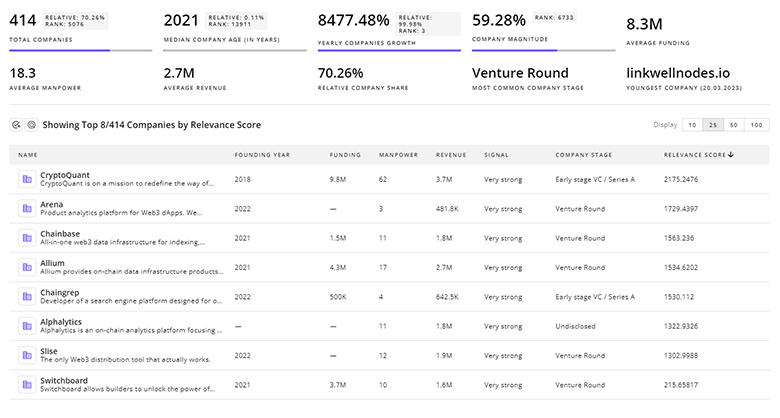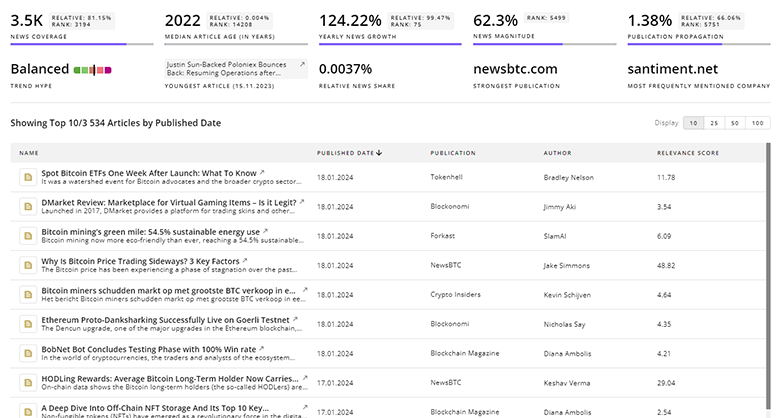
Last Mile Logistics Report
: Analysis on the Market, Trends, and TechnologiesThe last mile logistics sector is accelerating under pressure from e-commerce and customer speed demands: the internal trend data records a market size of $131.5 billion in 2021 and projects $183.9 billion by 2030, indicating sustained opportunity for efficiency and technology plays. Investments in AI route optimization, micro-fulfilment, and electrified fleets are the operational levers that will compress cost-per-delivery and meet tighter delivery windows while regulatory and infrastructure constraints (drone BVLOS rules, urban congestion) define near-term deployment limits.
Our latest update of this report was 8 days ago. If you found a mistake or missing information, tell us!
Topic Dominance Index of Last Mile Logistics
The Topic Dominance Index evaluates Last Mile Logistics's significance by analyzing data on the distribution of news articles that mention Last Mile Logistics, the timeline of newly founded companies working in this sector, and global search trends
Key Activities and Applications
- AI route planning and dynamic dispatching — real-time traffic, delivery priority and load constraints feed algorithmic route reassignments that materially reduce drive time and idle hours.
- Micro-fulfilment and urban hubs — compact fulfilment nodes placed near dense demand pockets to enable same-day and sub-day delivery economics.
- Crowdsourced and hybrid fleet orchestration — blending gig drivers, third-party carriers and owned assets to scale capacity and lower fixed cost exposure.
- Electrified urban fleets and cargo bikes — targeted substitution of ICE vans with e-vans, e-bikes and cargo bikes to cut emissions and urban operating costs.
- Autonomous ground robots and drones for short routes and constrained areas — pilot-to-commercial progression in campus, suburban and rural corridors where regulation and payload limits permit.
- Smart parcel lockers and OOH (out-of-home) pickup networks — reduce failed deliveries and return friction while smoothing last-mile route density.
- Delivery analytics and predictive ETAs — spatial business analytics and delivery-level KPIs to reduce exceptions and prioritize corrective actions.
Emergent Trends and Core Insights
- AI is the dominant productivity lever — AI-driven routing and demand forecasting drive measurable labor and fuel savings and are central to platform differentiation.
- Micro-fulfilment economics tighten delivery windows — deploying small urban fulfilment nodes materially reduces trip length and supports same-day offers that customers increasingly expect researchnester - Last Mile Delivery Market.
- Electrification converts regulation into advantage — EVs and e-bikes address emissions targets and, where supported by policy or incentives, lower operating cost per km over a fleet life cycle gminsights - Last Mile Delivery Market.
- Autonomous pilots move into hybrid operating models — ground robots, tele-operated vehicles and drones are combining with human fleets to cover distinct segments (campus, suburban, rural) rather than replacing human fleets wholesale Maersk Last-Mile Delivery Innovations.
- Customer expectations compress tolerances — majority demand faster and more personalised options (narrow delivery windows, pickup flexibility), raising the value of precise ETA and flexible routing systems DocShipper Trends 2025.
- Cost pressure forces shared-economy and platform approaches — pooling routes, lockers and micro-hubs reduces empty miles and unlocks utilization gains for incumbents and new entrants last-mile delivery market analysis.
Technologies and Methodologies
- Machine learning for route optimization, demand forecasting and dynamic pricing — core software capability for reducing stop time and fuel use futuremarketinsights - Last Mile Delivery Software Market.
- IoT sensors and telematics for real-time vehicle and parcel visibility — improves exception handling and enables condition-sensitive (cold chain) last-mile deliveries thebusinessresearchcompany - Last-Mile Delivery Software Market.
- Cloud SaaS orchestration platforms (fleet, order, customer UX) — rapid integration with ERP/WMS/TMS and scaling across geographies last-mile delivery software market.
- Electric vehicle fleets and e-mobility services, including vehicle-as-a-service and battery swapping — lower urban operating costs and accelerate sustainability KPIs gminsights - First Mile Delivery Market.
- Small autonomous robots, teleoperation and BVLOS drone stacks — suitable for predictable micro-routes and low-complexity deliveries where regulation allows TechTarget Last-mile trends.
- Smart locker networks and OOH pickup management using spatial analytics — reduce failed delivery rates and aggregate drop-off density.
Last Mile Logistics Funding
A total of 843 Last Mile Logistics companies have received funding.
Overall, Last Mile Logistics companies have raised $86.2B.
Companies within the Last Mile Logistics domain have secured capital from 3.7K funding rounds.
The chart shows the funding trendline of Last Mile Logistics companies over the last 5 years
Last Mile Logistics Companies
- Envimo — small Barcelona startup building autonomous sidewalk robots for urban deliveries; the company emphasizes modular, replaceable components to reduce downtime and claims an emissions and operating-cost advantage for dense short-route deliveries.
- Aeromile — early-stage drone integrator that pairs truck routes with UAV handoffs to shorten urban trip times; targets mixed truck+drone flows to reduce average delivery time for fringe urban and rural routes.
- Mily Technologies — delivery analytics and spatial business intelligence provider focused on parcel/postal operators; their platform combines spatial enrichment and operational KPIs to prioritize network tuning and locker placement decisions.
- Fixlastmile — configurable last-mile SaaS delivering route planning, delivery associate management and automated resource allocation for mid-market fleets in India; positions as a plug-and-play dispatch layer to cut delivery errors and improve on-time performance.
- Logibee — AI-orchestration platform from Bangalore offering route optimization, visibility and ETA prediction for regional couriers; built to integrate with local carrier networks and improve dispatch efficiency at scale.
Explore comprehensive profiles of 3.0K companies shaping the future of Last Mile Logistics with TrendFeedr's Companies feature.

3.0K Last Mile Logistics Companies
Discover Last Mile Logistics Companies, their Funding, Manpower, Revenues, Stages, and much more
Last Mile Logistics Investors
TrendFeedr’s Investors tool allows you to explore detailed investment activities and trends based on 4.5K Last Mile Logistics investors. This tool provides an in-depth analysis of funding rounds and market dynamics to make informed investment decisions.

4.5K Last Mile Logistics Investors
Discover Last Mile Logistics Investors, Funding Rounds, Invested Amounts, and Funding Growth
Last Mile Logistics News
Stay updated with TrendFeedr’s News feature, which offers you access to 3.0K Last Mile Logistics articles. This tool provides you with a comprehensive understanding of the historical and current trends shaping the market.

3.0K Last Mile Logistics News Articles
Discover Latest Last Mile Logistics Articles, News Magnitude, Publication Propagation, Yearly Growth, and Strongest Publications
Executive Summary
The business imperative is clear: last-mile operators must combine AI orchestration, dense fulfilment architecture and low-emission vehicles to meet tightening speed and ESG expectations while protecting margins. Near term, buyers should prioritize software that raises utilization (dynamic routing, pooled fulfilment and locker networks) and pilots electrified fleets where regulatory incentives exist. Strategically, companies that can integrate analytics, execution and physical capacity (micro-hubs, shared lockers, hybrid fleets) will convert short-term operational gains into defensible platform positions as the market consolidates and higher growth scenarios materialize.
We’re keen to partner with subject matter experts to enrich our coverage. Think you can help? Let us know.












